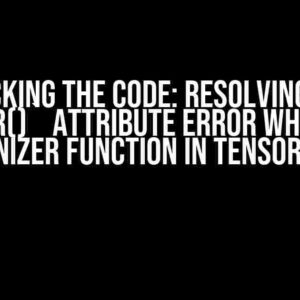If you’re reading this, chances are you’ve encountered the frustrating error “ValueError: Unrecognized data type” while trying to train your machine learning model using TensorFlow Keras’ Model.fit() method. Don’t worry, you’re not alone! This error can be caused by a variety of reasons, and in this comprehensive guide, we’ll explore the most common causes and provide step-by-step solutions to get your model up and running.
What’s causing the error?
The “ValueError: Unrecognized data type” error typically occurs when the data type of your input data is not compatible with the model’s expectations. This can happen due to various reasons, including:
- Incorrect data type of the input features
- Inconsistent data types across different samples
- Missing or null values in the data
- Unsupported data types, such as strings or objects
Before we dive in: A quick recap of Model.fit()
Just to ensure we’re all on the same page, let’s quickly go over the basics of Model.fit(). The Model.fit() method is used to train a Keras model on a given dataset. It takes in three main arguments:
x: The input data, typically a NumPy array or a pandas DataFramey: The target data, typically a NumPy array or a pandas Seriesbatch_size: The number of samples to include in each training batch
model.fit(x, y, batch_size=32, epochs=10, verbose=1)
Solution 1: Check your data types
The first and most important step is to ensure that your input data has the correct data types. TensorFlow Keras supports the following data types:
- float32
- float64
- int32
- int64
- bool
To check the data types of your input features, you can use the following code:
import pandas as pd # Assume 'df' is your pandas DataFrame print(df.dtypes)
If you find that your data types are not compatible with the supported types, you’ll need to convert them. For example, if you have a column with string values, you can convert it to a numerical representation using techniques like one-hot encoding or label encoding.
Solution 2: Handle missing or null values
Missing or null values can also cause the “ValueError: Unrecognized data type” error. To handle missing values, you can use the following strategies:
- Remove rows with missing values: This is the simplest approach, but it may lead to biased results if the missing values are not missing at random.
- Replace missing values with a specific value: You can replace missing values with a specific value, such as the mean or median of the column.
- Impute missing values using a machine learning algorithm: This approach involves training a machine learning algorithm to predict the missing values based on the available data.
In pandas, you can use the dropna() method to remove rows with missing values:
df.dropna(inplace=True)
Solution 3: Ensure consistent data types
If you have multiple features with different data types, ensure that they are consistent across all samples. For example, if you have a feature with both integer and float values, convert it to a single data type.
import numpy as np # Assume 'df' is your pandas DataFrame df['feature'] = df['feature'].astype(np.float32)
Solution 4: Avoid unsupported data types
TensorFlow Keras does not support certain data types, such as strings or objects. If you have features with these data types, you’ll need to convert them to a supported type. For example, you can convert categorical strings to numerical values using label encoding:
from sklearn.preprocessing import LabelEncoder le = LabelEncoder() df['category'] = le.fit_transform(df['category'])
Additional Tips and Tricks
In addition to the above solutions, here are some additional tips and tricks to keep in mind:
- Use the
to_categorical()method to convert categorical labels to a numerical representation. - Use the
normalize()method to normalize your data, which can improve model performance. - Check for any data leakage between your training and testing sets.
- Use the
verboseargument in Model.fit() to monitor the training process and identify potential issues.
Conclusion
The “ValueError: Unrecognized data type” error in TensorFlow Keras’ Model.fit() can be frustrating, but it’s often caused by simple mistakes in data preparation. By following the solutions and tips outlined in this guide, you should be able to identify and fix the issue and get your model up and running. Remember to always check your data types, handle missing or null values, ensure consistent data types, and avoid unsupported data types. Happy modeling!
| Solution | Description |
|---|---|
| Check data types | Ensure that your input data has the correct data types supported by TensorFlow Keras. |
| Handle missing or null values | Remove or replace missing values to prevent the error. |
| Ensure consistent data types | Ensure that features with different data types are consistent across all samples. |
| Avoid unsupported data types | Convert unsupported data types, such as strings or objects, to a supported type. |
By following this comprehensive guide, you should be able to resolve the “ValueError: Unrecognized data type” error and successfully train your machine learning model using TensorFlow Keras’ Model.fit(). Happy modeling!
Frequently Asked Question
Get ready to dive into the world of TensorFlow Keras and resolve that pesky “ValueError: Unrecognized data type” issue!
Q: What is the most common cause of the “ValueError: Unrecognized data type” error in TensorFlow Keras?
A: The most common cause of this error is when the data type of the input data is not supported by the model. This can happen when you’re trying to fit the model with data that contains categorical variables, strings, or other unsupported data types. Make sure to preprocess your data and convert it into a format that the model can understand!
Q: How can I check the data type of my input data to ensure it’s compatible with my TensorFlow Keras model?
A: You can use the `.dtypes` attribute in Pandas to check the data type of each column in your dataset. For example, `df.dtypes` will show you the data type of each column in your DataFrame. Alternatively, you can use the `.info()` method to get a concise summary of your dataset, including the data type of each column.
Q: What if I have categorical variables in my dataset? How can I preprocess them for my TensorFlow Keras model?
A: Ah-ha! Categorical variables can be tricky, but there are a few ways to preprocess them. One way is to use the `pd.get_dummies()` function from Pandas to one-hot encode your categorical variables. Another way is to use the `LabelEncoder` from Scikit-learn to convert your categorical variables into numerical values. You can also use `tf.keras.utils.to_categorical()` to one-hot encode your categorical variables specifically for TensorFlow Keras models.
Q: Can I use string data types as input to my TensorFlow Keras model?
A: Unfortunately, no! TensorFlow Keras models don’t support string data types as input. You’ll need to preprocess your string data by converting it into numerical values using techniques like tokenization, word embeddings, or encoding. You can use libraries like NLTK, spaCy, or TensorFlow’s own `tf.string` module to help with this process.
Q: What if I’m still getting the “ValueError: Unrecognized data type” error after preprocessing my data?
A: Don’t panic! If you’ve preprocessed your data and are still getting the error, try checking the shape and structure of your input data. Make sure it’s in the correct format and shape that your model expects. Also, double-check that you’re passing the correct data types to the `fit()` method. If all else fails, try resetting your Keras session or reinstalling TensorFlow Keras.




